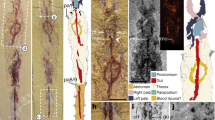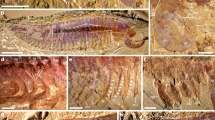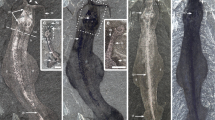Abstract
Cambrian fossil Lagerstätten preserving soft-bodied organisms have contributed much towards our understanding of metazoan origins1,2,3. Lobopodians are a particularly interesting group that diversified and flourished in the Cambrian seas. Resembling ‘worms with legs’, they have long attracted much attention in that they may have given rise to both Onychophora (velvet worms)4,5,6 and Tardigrada (water bears)7,8, as well as to arthropods in general9,10,11,12. Here we describe Diania cactiformis gen. et sp. nov. as an ‘armoured’ lobopodian from the Chengjiang fossil Lagerstätte (Cambrian Stage 3), Yunnan, southwestern China. Although sharing features with other typical lobopodians, it is remarkable for possessing robust and probably sclerotized appendages, with what appear to be articulated elements. In terms of limb morphology it is therefore closer to the arthropod condition, to our knowledge, than any lobopodian recorded until now. Phylogenetic analysis recovers it in a derived position, close to Arthropoda; thus, it seems to belong to a grade of organization close to the point of becoming a true arthropod. Further, D. cactiformis could imply that arthropodization (sclerotization of the limbs) preceded arthrodization (sclerotization of the body). Comparing our fossils with other lobopodian appendage morphologies—see Kerygmachela9,10, Jianshanopodia13 and Megadictyon12—reinforces the hypothesis that the group as a whole is paraphyletic, with different taxa expressing different grades of arthropodization.
This is a preview of subscription content, access via your institution
Access options
Subscribe to this journal
Receive 51 print issues and online access
$199.00 per year
only $3.90 per issue
Buy this article
- Purchase on Springer Link
- Instant access to full article PDF
Prices may be subject to local taxes which are calculated during checkout




Similar content being viewed by others
References
Hou, X.-G., Ramsköld, L. & Bergström, J. Composition and preservation of the Chengjiang fauna—a lower Cambrian soft-bodied biota. Zool. Scr. 20, 395–411 (1991)
Shu, D.-G. et al. Lower Cambrian vertebrates from south China. Nature 402, 42–46 (1999)
Chen, J.-Y. & Zhou, G.-Q. Biology of the Chengjiang fauna. Bull. Natl Mus. Nat. Sci. 10, 11–115 (1997)
Whittington, H. B. The lobopod animal Aysheaia pedunculata Walcott, Middle Cambrian, Burgess Shale, British Columbia. Phil. Trans. R. Soc. B 284, 165–197 (1978)
Hou, X.-G. & Bergström, J. Cambrian lobopodians—ancestors of extant onychophorans? Zool. J. Linn. Soc. 114, 3–19 (1995)
Ramsköld, L. & Chen, J.-Y. in Arthropod Fossils and Phylogeny (ed. Edgecombe, G. ) 77–93 (Columbia Univ. Press, 1998)
Delle Cave, L. & Simonetta, A. M. Notes on the morphology and taxonomic position of Aysheaia (Onychophora?) and of Skania (undetermined phylum). Monit. Zool. Ital. 9, 67–81 (1975)
Budd, G. E. Tardigrades as “stem-group arthropods”: the evidence from the Cambrian fauna. Zool. Anz. 240, 265–279 (2001)
Budd, G. E. A Cambrian gilled lobopod from Greenland. Nature 364, 709–711 (1993)
Budd, G. E. The morphology and phylogenetic significance of Kerygmachela kierkegaardi Budd (Buen Formation, Lower Cambrian, N Greenland). Trans. R. Soc. Edinb. Earth Sci. 89, 249–290 (1999)
Liu, J.-N., Shu, D.-G., Han, J. & Zhang, Z.-F. A rare lobopod with well-preserved eyes from Chengjiang Lagerstätte and its implications for origin of arthropods. Chin. Sci. Bull. 49, 1063–1071 (2004)
Liu, J.-N., Shu, D.-G., Han, J., Zhang, Z.-F. & Zhang, X.-L. Morpho-anatomy of the lobopod Megadictyon cf. haikouensis from the Early Cambrian Chengjiang Lagerstätte, South China. Acta Zool. 88, 279–288 (2007)
Liu, J.-N., Shu, D.-G., Han, J., Zhang, Z.-F. & Zhang, X.-L. A large xenusiid lobopod with complex appendages from the Chengjiang Lagerstätte (Lower Cambrian, China). Acta Palaeontol. Pol. 51, 215–222 (2006)
Dzik, J. & Krumbiegel, G. The oldest ‘onychophoran’ Xenusion: a link connecting phyla? Lethaia 22, 169–181 (1989)
Edgecombe, G. D. Arthropod phylogeny: an overview from the perspectives of morphology, molecular data and the fossil record. Arthropod Struct. Dev. 39, 74–87 (2010)
Maas, A., Mayer, G., Kristensen, R. M. & Waloszek, D. A Cambrian micro-lobopodian and the evolution of arthropod locomotion and reproduction. Chin. Sci. Bull. 52, 3385–3392 (2007)
Waloszek, D., Chen, J.-Y., Maas, A. & Wang, Y.-Q. Early Cambrian arthropods—new insights into arthropod head and structural evolution. Arthropod Struct. Dev. 34, 189–205 (2005)
Ma, X.-Y., Hou, X.-G. & Bergström, J. Morphology of Luolishania longicruris (Lower Cambrian, Chengjiang Lagerstätte, SW China) and the phylogenetic relationships within lobopodians. Arthropod Struct. Dev. 38, 271–291 (2009)
Willmer, P. Invertebrate Relationships: Patterns in Animal Evolution 273–296 (Cambridge Univ. Press, 1991)
Wang, X.-Q. & Chen, J.-Y. Possible developmental mechanisms underlying the origin of crown lineages of arthropods. Chin. Sci. Bull. 49, 49–53 (2004)
Bergström, J., Hou, X.-G., Zhang, X.-G. & Clausen, S. A new view of the Cambrian arthropod Fuxianhuia. GFF 130, 189–201 (2008)
Hou, X.-G., Bergström, J. & Ahlberg, P. Anomalocaris and other large animals in the Lower Cambrian Chengjiang fauna of southwest China. GFF 117, 163–183 (1995)
Collins, D. The “evolution” of Anomalocaris and its classification in the arthropod class Dinocarida (nov.) and order Radiodonta (nov.). J. Palaeont. 70, 280–293 (1996)
Kühl G, Briggs, D. E. G. & Rust, J. A Great-Appendage arthropod with a radial mouth from the Lower Devonian Hunsrück Slate, Germany. Science 323, 771–773 (2009)
Acknowledgements
This work was supported by a Research Scholarship from the Alexander von Humboldt Foundation at the Freie Universität Berlin, the National Science Foundation of China (grants 40802011 and 40830208) and the MOST Special Fund from the State Key Laboratory of Continental Dynamics, Northwest University (to J.L.), and a DFG grant within the Forschergruppe 736 (to H.K. and M.S.). We thank M. G. Chi for the reconstruction, J. Evers and M. Y. Sun for photography and table, and local workers for their strenuous field work.
Author information
Authors and Affiliations
Contributions
J.L. collected most of the fossils, described them and wrote the paper with the other authors; M.S. collected material and was involved in the phylogenetic analysis; J.A.D. contributed to the discussion; H.K. and D.S. were involved in technical aspects of the analysis; Q.O. provided three specimens. J.H. and Z.Z. contributed to fieldwork; X.Z. was involved in the analysis.
Corresponding author
Ethics declarations
Competing interests
The authors declare no competing financial interests.
Supplementary information
Supplementary Information
The file contains Supplementary Data, Supplementary Figure 1 and legend, Supplementary Table 1 and additional references. (PDF 444 kb)
Rights and permissions
About this article
Cite this article
Liu, J., Steiner, M., Dunlop, J. et al. An armoured Cambrian lobopodian from China with arthropod-like appendages. Nature 470, 526–530 (2011). https://doi.org/10.1038/nature09704
Received:
Accepted:
Published:
Issue Date:
DOI: https://doi.org/10.1038/nature09704
This article is cited by
-
A Cambrian unarmoured lobopodian, †Lenisambulatrix humboldti gen. et sp. nov., compared with new material of †Diania cactiformis
Scientific Reports (2018)
-
Cambrian suspension-feeding lobopodians and the early radiation of panarthropods
BMC Evolutionary Biology (2017)
-
A superarmoured lobopodian from the Cambrian Stage 4 of southern China
Science Bulletin (2016)
-
An embryological perspective on the early arthropod fossil record
BMC Evolutionary Biology (2015)
-
Oscillation of the velvet worm slime jet by passive hydrodynamic instability
Nature Communications (2015)
Comments
By submitting a comment you agree to abide by our Terms and Community Guidelines. If you find something abusive or that does not comply with our terms or guidelines please flag it as inappropriate.



